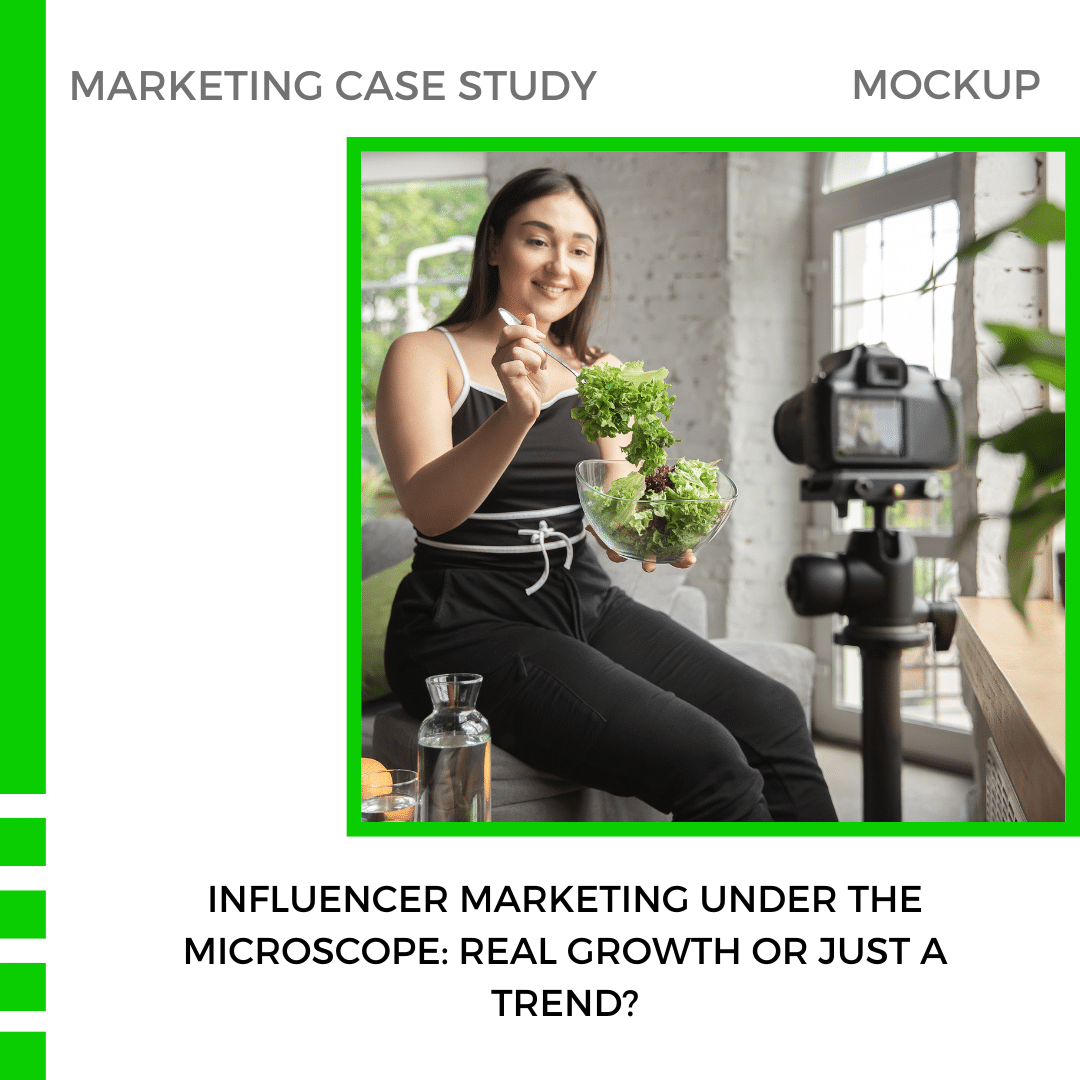
Influencer Marketing Under the Microscope: Real Growth or Just a Trend?
Introduction
Influencer marketing has reshaped modern advertising, offering brands a direct channel to engage audiences by partnering with famous social media figures. In this case study, we examine Glow Beauty, a cosmetics brand specializing in organic, cruelty-free products, and its recent influencer marketing campaign. Through collaborations with social media influencers, Glow Beauty aimed to enhance brand awareness, drive sales, and foster engagement among its target demographic of younger consumers (18-35). This analysis delves into Glow Beauty’s influencer-driven campaign strategies, impact, and ethical considerations.
Objectives:
- Understand the principles and potential of influencer marketing.
- Analyze how influencer campaigns impact brand awareness and sales.
- Evaluate strategies and metrics used to gauge campaign success.
- Identify ethical challenges in influencer marketing, such as transparency and authenticity.
Background Information
Key Concepts
- Influencer Marketing: A strategy involving endorsements and content from influential individuals in specific niches. Brands leverage these personalities to build credibility and reach new audiences.
- Engagement Rate: Measures interaction levels (likes, comments, shares) on influencer content, reflecting audience interest and impact.
- Return on Investment (ROI): A metric for evaluating the profitability of marketing investments.
- Conversion Rate: Tracks how many consumers take an action, like making a purchase, after engaging with influencer content.
Glow Beauty is a mid-sized company that aims to expand its reach and boost sales through an influencer campaign targeting eco-conscious consumers.
Influencer Marketing Campaign
Campaign Objectives
Glow Beauty’s campaign had three main objectives:
- Boost Brand Awareness: Increase the brand’s visibility and recognition.
- Drive Sales: Convert influencer followers into customers.
- Enhance Engagement: Promote interactions and build a loyal social media community.
Campaign Strategy
The company collaborated with a diverse group of influencers:
- Luna Smith: An Instagram beauty influencer with a large following specialising in organic makeup tutorials.
- Alex Perez: A YouTube personality focused on eco-friendly living.
- Mia Wong: A TikTok micro-influencer known for skincare tips.
Each influencer shared sponsored posts, created tutorial videos, and held giveaways to maximize campaign reach.
Campaign Metrics
To measure the campaign’s effectiveness, Glow Beauty tracked:
- Engagement Rates: Evaluating how followers interacted with posts.
- Sales Data: Monitoring sales generated through unique promotional codes.
- Brand Mentions: Tracking the frequency of Glow Beauty mentions online.
- Follower Growth: Analyzing increases in Glow Beauty’s social media followers.
For students, analyzing these metrics offers insight into the campaign’s performance and the broader impact of influencer marketing on brand growth.
Case Study Analysis
Task 1: Assess Campaign Performance
- Engagement Rate Analysis
Each influencer’s content was reviewed for engagement rates, focusing on how well they stimulated user interactions for Glow Beauty. With an engagement rate of 5%, Luna Smith generated high reach but saw lower engagement compared to Mia Wong, whose 10% rate, though on a smaller audience, indicated deeper follower interaction. - Sales Data Evaluation
Promo code analysis showed that Luna Smith’s large follower base translated into the highest revenue, but Mia Wong achieved a strong ROI, with more conversions per follower. This suggests that micro-influencers can offer meaningful impact through focused, loyal audiences.
Task 2: Measure Brand Awareness
- Brand Mentions and Sentiment
A spike in brand mentions during the campaign indicated increased consumer awareness and positive sentiment. Glow Beauty saw mentions rise from 200 to 1,000 weekly during the campaign, signalling improved brand visibility. - Follower Growth
Glow Beauty gained 10,000 new followers, with the largest spike aligning with Luna Smith’s posts. These new followers represent potential future customers and show that influencer marketing effectively drives organic follower growth.
Task 3: Discuss Challenges and Ethical Considerations
- Authenticity and Trust
Authenticity is vital in influencer marketing. Consumers respond better to genuine endorsements, but there is a risk of influencer fraud, such as fake followers or insincere promotions. Glow Beauty must ensure its influencers align with the brand values to maintain trust. - Disclosure and Transparency
Disclosure rules require influencers to label sponsored content. This transparency helps consumers make informed decisions and builds brand trust. Glow Beauty should encourage influencers to comply with regulations, such as those provided by the Federal Trade Commission (FTC), to enhance campaign credibility.
Tasks for Students
- Analyze Engagement Rates: Examine how well each influencer engaged with their audience.
- Evaluate Sales Impact: Measure the financial impact of the campaign using sales data.
- Discuss Brand Sentiment: Analyze public perception of Glow Beauty post-campaign.
- Consider Ethical Issues: Evaluate the importance of trust and disclosure in influencer marketing.
Possible Solution: A Hybrid Approach to Influencer Marketing
To maximize influencer marketing effectiveness, Glow Beauty could implement a Hybrid Influencer Strategy:
- Strategic Influencer Selection: Prioritize a mix of micro- and macro-influencers. Micro-influencers can provide high engagement, while macro-influencers offer a broader reach, balancing scale and impact.
- Customized Engagement Tactics: Interactive content like live Q&As, tutorials, and user-generated content can improve consumer engagement. Partnering with influencers on cross-platform collaborations and user-driven challenges could amplify reach.
- Data-Driven Optimization: Use analytics tools to assess engagement, sentiment, and sales data in real-time. By continuously refining based on feedback, Glow Beauty can adopt strategies to maximize ROI. Learn more about analytics and optimization from Google Analytics.
This hybrid strategy offers flexibility, allowing Glow Beauty to reach diverse segments while refining campaigns based on data insights.
Conclusion
The Glow Beauty case study highlights influencer marketing as an effective tool for strategically boosting brand awareness, sales, and engagement. However, it also underscores the challenges brands face in selecting influencers, ensuring transparency, and fostering authentic consumer connections. Glow Beauty’s campaign generated significant awareness and engagement, but addressing ethical concerns and refining strategies will be key to future success.
By employing a Hybrid Influencer Strategy, Glow Beauty can improve its influencer selection, engage audiences through interactive content, and optimize campaigns with data-driven insights. This case study offers valuable lessons on the complexities and rewards of influencer marketing for long-term brand growth.
Explore Business Models of Global Companies and Indian Companies
Tag:brand awareness, brand perception, consumer trust, conversion rate, engagement metrics, engagement rate, ethical influencer marketing, Glow Beauty, hybrid marketing strategy, influencer fraud, influencer marketing, marketing strategy, marketing transparency, micro-influencers, organic beauty, ROI in marketing, social media influencers



